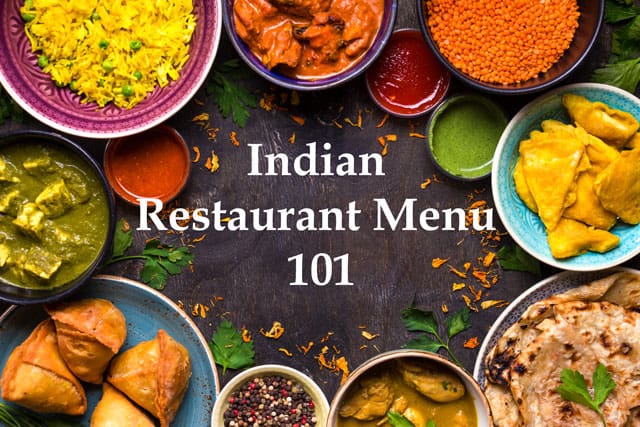This Indian food guide is a cheat sheet for Indian restaurant menus. It covers the most popular Indian dishes — what they are, how they’re served & more!
The Indian sub-continent is blessed with diversity, and with the vast expanse of people, culture and traditions, food becomes a life line, a common connection for all. As a wise person once said, ‘there is no love more sincere, than the love for food’.
Putting our traditional dishes in the spotlight here are the most famous dishes from each state of the country you must try, before you say goodbye.
Misal pav is a popular street food in Maharashtra. A great breakfast recipe that includes a curry made of sprouts, topped with finely chopped onions, tomatoes and ‘farsan’(fried savory mixture) and lime juice served pav, heated on the pan with a hint of butter.
Punjab: Makki Di Roti & Sarson Da Saag

Makki di Roti is a corn meal Indian bread that tastes fabulous with ‘Sarson saag’ – mustard green and a glass of lassi. The dish is regarded as the traditional way to prepare saag and is usually served with makki di roti literally (unleavened cornbread). It can be topped with either Makkhan (unprocessed white butter or processed yellow butter) or more traditionally with ghee.
West Bengal: Kosha Mangsho

This Spicy Bengali Mutton Curry aka Kosha Mangsho is a perfect lunch recipe that would be loved by all. Velvety gravy with juicy pieces of meat served with maida luchi (pooris), full of flavors from the mutton, spices and mustard oil.
Gujarat: Dhokla

Dhokla is a vegetarian dish made from a fermented batter of rice and split chickpeas. It is served with tangy chutneys and can be eaten for breakfast, as a main course, as a side dish, or as a snack.
 WHY WE CREATED THIS GUIDE TO POPULAR INDIAN FOOD
WHY WE CREATED THIS GUIDE TO POPULAR INDIAN FOOD
I love Indian food. All Indian food. However, when I ask people what their favorite Indian dish is, the answer more often than not is “Chicken Tikka Masala.” This has always bothered me a bit. Now, don’t get me wrong, Chicken Tikka Masala is AMAZING! In fact, if I had to pick one Indian dish to introduce to a non convert, it would probably be Chicken Tikka Masala. But there is so much more to Indian food!
The more I questioned people, the more I found out that it wasn’t that they didn’t like other Indian dishes, they simply felt intimidated by the names and did not understand them. The irony here is that Indian food names are quite simple. The dishes are usually named after the main components or where they come from. But given that fact, if I did not understand the language, I’d be confused too.
So consider this my effort to make things right. Here’s a rundown on what you commonly find on a typical Indian restaurant menu. Now next time when you go to your favorite Indian restaurant to enjoy a meal, use this guide to the most popular Indian dishes and order something outside of your comfort zone. There’s a good chance you will be surprised to know how much goodness you were missing out on!
If you would like to enjoy Indian food at home, you can purchase our products. They are at a store near you, or you can make the most popular dishes at home with our Home Chef Collection products.
INDIAN APPETIZERS
odium is essential in our diet because it is an element that the body needs to function properly. This can be found in salt and are present in some foods so naturally and if not, add ourselves.
Healthy people need a quantity of this element, but what happens when we have a disease such as hypertension? It's simple, we need a minimum amount.
Did you know that the body uses sodium to control blood pressure? It is true and not only that but also the blood volume. In addition, the body also needs sodium for muscles and nerves to function properly.

In addition, sodium can be found in foods such as milk and meat, that is why we must be even more careful with what we consume since sodium is provided by the salt added during the preparation of food, by the consumption of ultra-processed foods, prepared condiments such as soy sauces, brine and by the high incorporation in the daily diet of bread, cakes, sugary drinks and more..

અહીંથી જુઓ ૨૯ રાજ્યો નો જમવાની વાનગી થાળી નો PDF
If you are a person living with hypertension, it is important to watch the amount of sodium you consume while eating it, as it can attract side effects or some complications such as the following:
Raise blood pressure
A severe buildup of fluid in people with heart failure.
Hepatic cirrhosis.
Renal disease.
It is important to know that sodium in the diet, which is called dietary sodium, is measured in milligrams (mg). The table salt that we use every day contains 40% sodium. One teaspoon of table salt contains 2,300 mg of sodium.
Knowing the above data, you should be more aware of how much salt you consume per day. But how much sodium should a person with hypertension consume per day?
Post a Comment